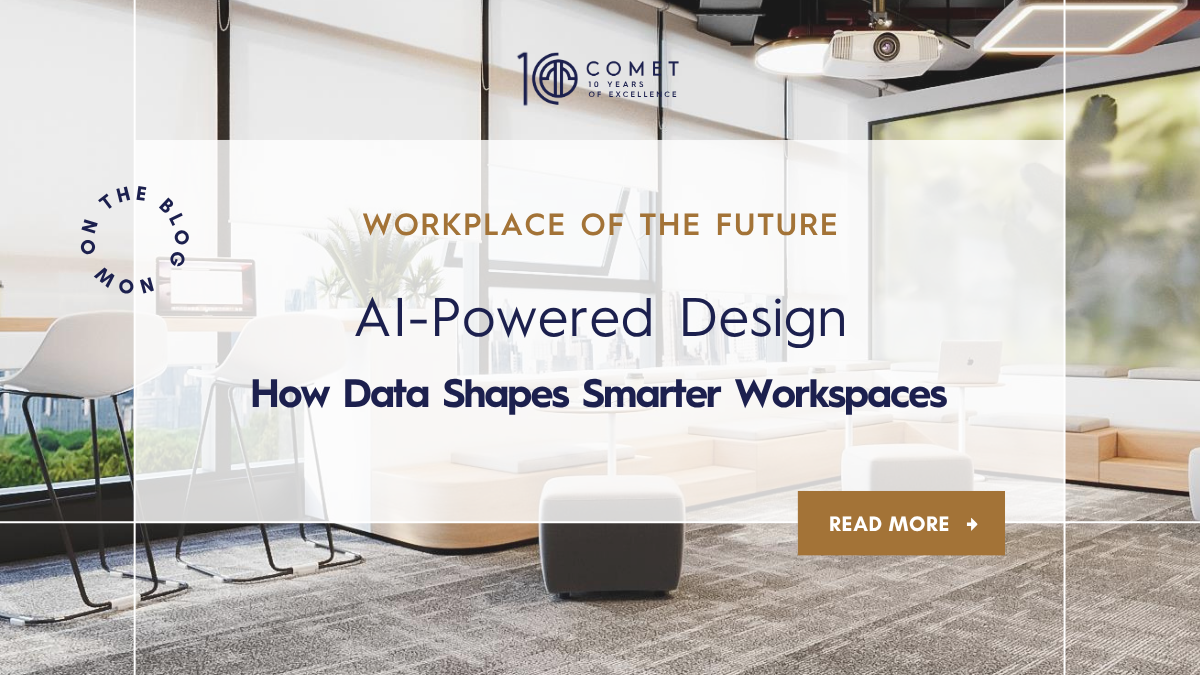
AI-Powered Design: How Data Shapes Smarter Workspaces
The Shift to Smarter Workspaces
For decades, workplace design relied heavily on intuition, trends, and aesthetics. While these elements still matter, 2025 has ushered in a new era of data-driven design powered by Artificial Intelligence (AI). Today, every design decision — from where to place a meeting pod to how much space a team needs — can be informed by real-time insights and predictive analytics.
This shift is redefining how organizations think about office spaces. It’s no longer about having more square meters — it’s about making every square meter work harder. The result is smarter, more efficient, and more human-centric workplaces that boost productivity, reduce costs, and improve employee experience.
Why AI in Design Matters
AI isn’t replacing the creativity of architects and designers; instead, it’s enhancing their decisions with data-driven evidence.
- For companies: AI translates workplace investments into measurable ROI.
- For employees: It creates environments that respond to their needs in real time.
- For designers: It transforms guesswork into strategic foresight.
According to recent research, companies that incorporate AI-powered workplace analytics report a 20–30% increase in space efficiency and up to a 25% boost in employee productivity.
Key Drivers of AI-Powered Workspace Design
1. Occupancy Analytics: Designing for Real Use, Not Assumptions
Traditional design often relies on assumptions about how employees use their space. AI changes that by using sensor-based data to reveal:
- How often desks, meeting rooms, and lounges are actually occupied.
- Peak traffic times and underutilized zones.
- Patterns of collaboration versus individual work.
This data allows designers to right-size spaces, reduce waste, and optimize layouts that reflect real behaviors — not outdated estimates.
2. Predictive Space Planning for Hybrid Work
The hybrid model has made office attendance unpredictable. AI uses historical data and machine learning to forecast attendance patterns, helping companies plan:
- The right number of workstations for fluctuating demand.
- Flexible seating areas that adjust dynamically.
- Smart booking systems that reduce conflicts and improve utilization.
This approach ensures that workspaces remain agile and cost-efficient without compromising the user experience.
3. Environmental Intelligence: Boosting Comfort and Well-Being
AI-enabled building systems now regulate lighting, temperature, ventilation, and acoustics in response to occupancy and environmental conditions.
For example:
- Lights dim automatically in unused zones.
- HVAC adjusts airflow based on room density.
- Acoustic sensors flag noisy areas and recommend interventions.
These real-time adjustments reduce energy costs by up to 30% while supporting employee comfort and wellness.
4. AI-Assisted Design Simulations
Before breaking ground, designers can use AI-powered tools to simulate how layouts will perform:
- Predict foot traffic flow to avoid congestion.
- Model acoustics to reduce noise issues.
- Test various seating arrangements for collaboration efficiency.
Such simulations enable data-backed decisions early in the design phase, saving time and costly changes later.
5. Personalized Employee Experiences
AI is bringing personalization to shared spaces. Using employee preferences and behavioral data, workplaces can:
- Suggest preferred work zones for different teams or roles.
- Adjust lighting or temperature for individual comfort in designated pods.
- Provide tailored notifications about available quiet zones or collaborative hubs.
This human-centric approach boosts satisfaction and engagement, which directly correlates with better retention rates.
Business Impact: Turning Data into ROI
When AI informs design, organizations achieve measurable benefits:
- Space Optimization: Reduce unused areas by 15–25%, lowering rent and operational costs.
- Productivity Gains: Better layouts and environmental comfort drive a 20–30% increase in performance.
- Employee Retention: Personalized, well-zoned offices improve well-being, helping retain talent.
- Sustainability: Smarter energy use lowers carbon footprint and aligns with ESG goals.
These numbers prove that AI-powered design isn’t a trend — it’s a competitive advantage.
Challenges to Consider
While the benefits are compelling, implementing AI-driven workplaces requires:
- Data Privacy Compliance: Ensuring employees’ location and usage data remain secure and anonymized.
- Change Management: Helping teams embrace new tools and processes.
- Integration with Existing Systems: Aligning sensors, software, and building infrastructure smoothly.
Organizations that address these challenges upfront can unlock the full potential of AI-enabled design.
Future Outlook: The Evolution of AI in Design
By 2030, experts predict that AI will be embedded in 80% of all new workplace projects. Offices will not only adapt to employee needs but also anticipate them — from predicting space requirements during peak project cycles to dynamically redesigning layouts for new teams.
The synergy between AI and human-led design will continue to evolve, ensuring that creativity drives vision while data guarantees precision.
Designing with Data for People and Performance
AI-powered design is reshaping what it means to create workspaces. It transforms offices from static spaces into intelligent, adaptive environments that prioritize people, performance, and ROI.
At Comet, we leverage cutting-edge design strategies and collaborate with technology partners to ensure that every square meter serves a measurable purpose — improving employee experience and supporting long-term business success.
📢 Call to Action
Visit cometarch.com to explore our innovative workplace projects.
Contact us today to learn how AI-powered design can make your workspace smarter, more efficient, and future-ready.
